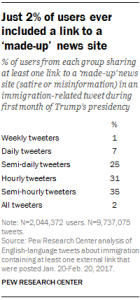Roughly six-in-ten U.S. teens have been bullied or harassed online, according to a new Pew Research Center report that explores teens’ experiences with cyberbullying and their views about it. Senior Researcher Monica Anderson discusses the methods and meaning behind the data.
Bullying has been around for decades, centuries even. Cyberbullying is a newer manifestation of bullying. How did you define cyberbullying for this research?
We’re aware that cyberbullying can be a very nuanced issue. Our own research has shown that what might be harassment to one person might not be considered harassment by another.


At the same time, other studies may use different measures to assess the prevalence of cyberbullying. For this project, we measured six specific incidents that teens might face online or on their cellphone: offensive name-calling, rumor-spreading, being sent explicit images without their consent, having explicit images of themselves shared without their consent, having someone other than a parent constantly asking where they are, what they’re doing or who they’re with, and physical threats. If a teen said they ever had one or more of those experiences, they were considered a target of cyberbullying.
Our definition was designed to show that these experiences can range from less severe forms of harassment – like name-calling that teens may shrug off – to more severe forms of online abuse that includes stalking or physical threats.
Could you explain how surveying teens can be different and, in some ways, more difficult than surveying adults?
One big challenge with surveying teens is that you first have to get consent from a parent. If we’re doing a study of adults, we can call them directly or use our American Trends Panel. Surveying teens requires a second level of contact, and the more times you have to contact respondents, the more difficult it can be.
One of the consistent things we’ve found is that teens have a lot of thoughtful and engaging things to say about their own experiences and what’s going on in the world around them. Monica Anderson
As far as the content of our research, one of the consistent things we’ve found is that teens have a lot of thoughtful and engaging things to say about their own experiences and what’s going on in the world around them. People sometimes wonder if we alter questions so that teens can better understand. At times, we do alter them. We might use phrases like “spreading drama” or “going viral” that have special relevance for teens. But for most of our technology-centered surveys we’re polling teens in the same way we poll adults.
What do you think is a standout finding from the research?
One key finding in our research of adults is that women are more likely than men to face sexualized forms of online harassment – and we see a similar finding in our work dealing with teens as well. For instance, teenage girls are more likely than boys to say they’ve received explicit images they did not ask for. That’s especially true for older teen girls: 35% of girls ages 15 to 17 have received unwanted explicit images.
Your previous research has shown that 41% of U.S. adults have personally experienced online harassment. In this report, we learn that 59% of U.S. teens have been bullied or harassed online. Can you talk about the differences between these two results?
For starters, we are looking at two different groups of people in these surveys, so we’d expect that their experiences might vary. But there are also striking similarities in the findings if you compare young adults and the teens. It’s clear that harassment is incredibly common for both groups: A majority of 18- to 29-year-olds say they’ve experienced some type of harassment online.
Teenage girls are more likely than boys to say they’ve received explicit images they did not ask for. That’s especially true for older teen girls: 35% of girls ages 15 to 17 have received unwanted explicit images. Monica Anderson
We also tailored some questions in an effort to capture the lived experiences of adults and young people. For example, we use slightly different questions to measure online harassment in our surveys of teens and adults. When we conducted focus groups with teens, they often mentioned how easy it is for people to spread rumors or lies about others via texting and social media. So, we explicitly include “spreading false rumors” in our surveys of teens.
But although some questions differ, there are consistencies in the overall findings. For example, name-calling is the most common form of online harassment for both teens and adults. And as noted above, adult women and teenage girls are more likely to experience sexualized forms of online harassment when compared with their male counterparts.
While the report is mainly based on teens’ experiences with cyberbullying, it also addresses parents’ views of the issue and discusses how teens rate certain groups, including parents and teachers, when it comes to addressing cyberbullying. What were some of the findings related to these other groups?
In general, parents are quite confident in their ability to teach their children about what they should and shouldn’t share online. It’s also very clear that both teens and parents see this as an important issue: About six-in-ten teens say that cyberbullying is a major problem for people their age, and a similar share of parents say they worry about their teen being harassed or bullied online. In fact, parents are one of the few groups that teens give relatively high marks when asked how they are doing at addressing cyberbullying.
Cyberbullying is becoming more present in people’s minds due to the recent research, documentaries and news stories about it. How do you think this contributes to the Center’s work, as well as to broader research on technology and its impact on society?
The issue of cyberbullying has been front and center in the public consciousness lately, with a number of lawmakers and first lady Melania Trump taking a stand on the subject. A number of states have enacted legislation on the topic, and school districts across the country are looking for ways to deal with the issue. We hope this research helps to shed light on the extent to which harassment and bullying have become a common feature of teen life and brings teens’ own voices and experiences to the broader debate.
Cyberbullying will inevitably change as technology does. Looking forward, are there ways that your team would like to expand the research?
One of the biggest policy questions surrounding this topic is how the public reconciles the desire for people being able to speak their mind freely, while simultaneously ensuring that people can still feel welcome and safe online. Our research with adults has found that Americans are divided on this question, and they can struggle to find consensus on what sorts of behaviors cross the line into outright harassment. There is a lot of work to be done to unpack public perceptions of these deeper issues that often underscore debates about online harassment.
In addition, our teens survey shows that young people generally have a negative assessment of how key groups (with the exception of their parents) are tackling cyberbullying. It would be worth understanding why teens feel this way and hearing their thoughts on what – if anything – can be done to curtail bad online behavior.
